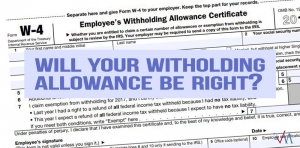Blog - Tax Related
Tax Time Has Arrived! Are You Ready?
Article Highlights:
|
|
If you're like most taxpayers, you find yourself with an ominous stack of "homework" around TAX TIME! Pulling together the records for your tax appointment is never easy, but the effort usually pays off in the extra tax you save! When you arrive at your appointment fully prepared, you'll have more time to:
|
|
Choosing Your Best Alternatives - The tax law allows a variety of methods of handling income and deductions on your return. Choices you make as you prepare your return often affect not only the current year but future returns as well. Topics these choices relate to including:
- Sales of property - If you're receiving payments on a sales contract over a period of years, you can sometimes choose between reporting the whole gain in the year you sell or over a period of time as you receive payments from the buyer.
- Depreciation - You're able to deduct the cost of your investment in certain business properties. You can either depreciate the costs over a number of years; or, in certain cases, deduct them all in one year.
Where to Begin? Preparation for your tax appointment should begin in January. Right after the New Year, set up a safe storage location, such as a file drawer, cupboard, or safe. As you receive pertinent records, file them right away, before you forget or lose them. Make this a habit, and you'll find your job a lot easier on your appointment date. Other general suggestions to prepare for your appointment include:
- Segregate your records according to income and expense categories. File medical expense receipts in one envelope or folder, mortgage interest payment records in another, charitable donations in a third, etc. If you receive an organizer or questionnaire to complete before your appointment, fill out every section that applies to you. (Important: Read all explanations and follow instructions carefully. By design, organizers remind you of transactions you may otherwise miss.)
- Call attention to any foreign bank account, foreign financial account, or foreign trust in which you have an ownership interest, signature authority, or controlling stake. We also need to know about foreign inheritances and ownership of foreign assets. In short, bring any foreign financial dealings to our attention so we know if you have any special reporting requirements. The penalties for not making and submitting required reports can be severe.
- If you acquired your health insurance through a government Marketplace you will receive Form 1095-A, issued by the Marketplace that will include information needed to complete your return. In addition, you will need to provide proof of insurance to avoid a penalty or qualify for one of the many exemptions from the penalty. If you received a hardship penalty exemption from the Marketplace you will have been issued an exemption certificate number (ECN). That number must be included on your tax return. The 1095-A and ECN documentation need to be included with the other material you bring to your appointment. If your insurance coverage was through an employer, and the employer issued Form 1095-B, 1095-C or a substitute form detailing your coverage, bring it to the appointment.
- Keep your annual income statements separate from your other documents (e.g., W-2s from employers, 1099s from banks, stockbrokers, etc., and K-1s from partnerships). Be sure to take these documents to your appointment, including the instructions for K-1s!
- Write down questions so you don't forget to ask them at the appointment. Review last year's return. Compare your income on that return to your income in the current year. A dividend from ABC stock on your prior-year return may remind you that you sold ABC this year and need to report the sale, or that you haven't yet received the current year's 1099-DIV form.
- Make sure you have social security numbers for all your dependents. The IRS checks these carefully and can deny deductions and credits for returns filed without them.
- Compare deductions from last year with your records for this year. Did you forget anything?
- Collect any other documents and financial papers that you're puzzled about. Prepare to bring these to your appointment so you can ask about them.
Accuracy Even for Details - To ensure the greatest accuracy possible in all detail on your return, make sure you review personal data. Check name(s), address(es), social security number(s) and occupation(s) on last year's return. Note any changes for this year. Although your telephone numbers and e-mail address aren't required on your return, they are always helpful should questions occur during return preparation.
Marital Status Change - If your marital status changed during the year, if you lived apart from your spouse or if your spouse died during the year, list dates and details. Bring copies of prenuptial, legal separation, divorce or property settlement agreements, if any, to your appointment. If your spouse passed away during the year, you should have a copy of his or her trust agreement or will available for review.
Dependents - If you have qualifying dependents, you will need to provide the following for each (if you previously provided us with items 1 through 3 you will not need to supply them again):
|
|
For anyone other than your child to qualify as your dependent, they must pass five strict dependency tests. If you think one or more other individuals qualify as your dependents (but you aren't sure), tally the amounts you provided toward their support vs. the amounts they provided. This will simplify the final decision.
Some Transactions Deserve Special Treatment - Certain transactions require special treatment on your tax return. It's a good idea to invest a little extra preparation effort when you have had the following transactions:
- Sales of Stock or Other Property: All sales of stocks, bonds, securities, real estate and any other property need to be reported on your return, even if you had no profit or loss. List each sale, and have purchased and sale documents available for each transaction.
The purchase date, sale date, cost, and selling price must all be noted on your return. Make sure this information is contained in the documents you bring to your appointment. - Gifted or Inherited Property: If you sell the property that was given to you, you need to determine when and for how much the original owner purchased it. If you sell the property you inherited, you need to know the original owner's death-date and the property's value at that time. You may be able to find this on estate tax returns or in probate documents; otherwise, ask the executor.
- Reinvested Dividends: You may have sold stock or a mutual fund in which you participated in a dividend reinvestment program. If so, you will need to have records of each stock purchase made with the reinvested dividends.
- Sale of Home: The tax law provides special breaks for home sale gains, and you may be able to exclude up to $500,000 of the gain from your primary home if you file a married joint return and meet certain ownership, occupancy, and holding period requirements. The maximum exclusion is $250,000 for others. Since the cost of improvements made in your home can also be used to reduce any gain, it is good practice to keep a record of them. The exclusion of gain applies only to a primary residence; so keeping a record of improvement to other property, such as your second home, is important. Be sure to bring a copy of the sale documents (usually the closing escrow statement).
- Purchase of a Home: Be sure to bring a copy of the final closing escrow statement if you purchased a home.
- Vehicle Purchase: If you purchased a new plug-in electric car (or cars) this year, you may qualify for special credit. Please bring the purchase statement to the appointment with you.
- Home Energy-Related Expenditures: If you installed a solar-electric system on your home or second home, please bring the details of the purchase and manufacturer's credit qualification certification to your appointment. You may qualify for a substantial energy-related tax credit.
- Identity Theft: Identity theft is rampant and can impact your tax filings. If you have reason to believe that your identity has been stolen, please contact this firm as soon as possible. The IRS provides special procedures for filing if you have had your identity stolen.
- Car Expenses: Where you have used one or more automobiles for business, list the expenses of each separately. The government requires your total mileage, business miles, and commuting miles for each business use of your car to be reported on your return, so be prepared to have those numbers available. If you were reimbursed for mileage through an employer, know the reimbursement amount and whether it is included in your W-2.
- Charitable Donations: You must substantiate cash contributions (regardless of amount) with a bank record or written communication from the charity showing the name of the charitable organization, date and amount.
Unreceipted cash donations put into a "Christmas kettle," church collection plate, etc., are not deductible. For clothing and household contributions, items donated must generally be in good or better condition, and items such as undergarments and socks are not deductible. You must keep a record of each item contributed that indicates the name and address of the charity, date, and location of the contribution, and a reasonable description of the property. Contributions valued under $250 and dropped at an unattended location do not require a receipt. For contributions above $500, the record must also include when and how the property was acquired and your cost basis in the property. For contributions above $5,000 and other types of contributions, please call this office for additional requirements.
If you have questions about assembling your tax data prior to your appointment, please give this office a call.
Maximize Your Tax Refunds with Our Checklist and Organizers
Tax Season is Here. We can help you with your tax preparation. Call us and schedule an appointment today! .....
Open Monday through Friday 9-7pm and Saturdays from 9-6pm. Our professionals are licensed and in good standing with Maryland Department of Licenses and Regulations.
You will need the following personal information to do your taxes;
|
|
Tax Documents for the current year;
|
|
Before you begin to organize your documents download the attached organizers to help you maximize your refund.
New Tax Changes on Home Mortgage Interest
Tags: Home and Mortgage, Tax Planning
Article Highlights:
|
|
Note: The is one of a series of articles explaining how the various tax changes made by the GOP's Tax Cuts & Jobs Act (referred to as the "Act" in the article), passed late in December 2017, might affect you and your family in 2018 and future years, and offering strategies you might employ to reduce your tax liability under the new tax laws.
For years, taxpayers have been able to deduct home mortgage interest on their primary and second homes as an itemized deduction, subject to certain limitations. The interest deduction was limited to the interest on up to $1 million of acquisition debt and $100,000 of equity debt.
Acquisition debt is the debt incurred to purchase, construct or substantially improve a taxpayer's principal or second home. So when you purchased your home, that original loan was acquisition debt, and if you later borrowed additional money that you used to add a room, pool, etc., that loan was also acquisition debt. However, if the total of all of your acquisition loans exceeded the $1 million limit, then the interest on the excess debt over $1 million was not deductible as acquisition debt interest.
Consumer debt interest, such as interest on auto loans and credit card debt, is not deductible as an itemized deduction. However, years ago, Congress allowed homeowners to deduct the interest on up to $100,000 of equity debt. This allowed homeowners to use the equity in their homes for any purpose and deduct the interest on the equity debt as an itemized deduction.
Well, That Has All Changed. For 2018 through 2025, the new tax law reduces the $1 million limit on home acquisition debt to $750,000 ($375,000 for married separate filers), except that the lower limit won't apply to indebtedness incurred before December 15, 2017. That is, the $1M cap continues to apply to acquisition mortgages on primary and second residences that were already in existence prior to December 15, 2017, as well as for taxpayers who entered into a binding written contract before that date to close on the purchase of a principal residence before January 1, 2018, and who purchase that residence before April 1, 2018.
The Equity Debt Interest Deduction Is No More – Congress has yanked the rug out from under those with equity debt on their homes. Beginning in 2018, interest paid on equity debt will no longer be allowed as a deduction, regardless of when the debt was incurred.
This seems a little unfair and can have an adverse impact on individuals who used their home as a piggy bank for personal expense purposes.
Whether any of this makes any difference in light of the new higher standard deduction amounts for 2018, and whether you should be looking for ways to pay down the equity debt, will depend upon the amounts of your other itemized deductions. Please call this office if you have any questions.
Will Your 2018 Withholding Be Right?
Article Highlights:
|
|
Note: The is one of a series of articles explaining how the various tax changes made by the GOP's Tax Cuts & Jobs Act (referred to as the "Act" in the article), passed late in December 2017, might affect you and your family in 2018 and future years, and offering strategies you might employ to reduce your tax liability under the new tax laws.
One of the first trouble spots of the new tax reform is the W-2 withholding for 2018. Passage of the new law in late December hasn't given the IRS much time to develop new withholding tables. This can be a big issue, as the recent Tax Cuts & Jobs Act (TCJA) substantially altered the tax rates and standard deductions, did away with exemption deductions, and increased the child tax credits—all elements of how the withholding allowances and tables have been structured in the past.
On January 11, the IRS released modified withholding tables for employers to use for determining employee withholding. Supposedly the new withholding tables have been crafted to use the information employers already have from employees' prior Form W-4s on file to adjust their employees' withholding, taking into account the tax cuts for individuals included in the TCJA.
The IRS is also working on revising the Form W-4 to reflect additional modifications in the new law, such as changes in available itemized deductions, increases in the child tax credit, the new dependent credit and repeal of the dependent exemptions deduction.
When available, the new Form W-4 can be used by employees who wish to update their withholding in response to the new law or changes in their personal circumstances in 2018 and by workers starting a new job. Until a new Form W-4 is issued, employees and employers should continue to use the 2017 Form W-4.
You are cautioned to keep an eye on your take-home pay to ensure your withholding has not changed too drastically once your employer starts using the new IRS tables. Most wage earners should see a decrease in withholding (and a larger net paycheck), but if the change is too radical you could end up owing tax next year when you file your 2018 return.
If you are self-employed and/or have other sources of taxable income in addition to wages, or if you itemize your deductions, the wage withholding by your employer-based upon your existing Form W-4 probably will not provide the correct withholding, and you may need to make adjustments to your withholding allowances or even make estimated tax payments.
As 2018 is the first year that the vast majority of the provisions of TCJA will apply, you should be cautious that your withholding is not too little, resulting in a tax due next filing season, or too high, denying you the benefits of the tax cut until you receive your refund next year.
Please call this office if you need assistance in determining your withholding or if you have questions about the new tax law.
2018 Standard Mileage Rates Announced
Article Highlights:
As it does every year, the Internal Revenue Service recently announced the inflation-adjusted 2018 optional standard mileage rates used to calculate the deductible costs of operating an automobile for business, charitable or medical purposes.
|
|
Beginning on Jan. 1, 2018, the standard mileage rates for the use of a car (or a van, pickup or panel truck) are:
|
|
The business standard mileage rate is based on an annual study of the fixed and variable costs of operating an automobile. The rate for medical purposes is based on the variable costs as determined by the same study. The rate for using an automobile while performing services for a charitable organization is statutorily set (it can only be changed by Congressional action) and has been 14 cents per mile for over 15 years.
Important Consideration: The 2018 rates are based on 2017 fuel costs. Based on the potential for substantially higher gas prices in 2018, it may be appropriate to consider switching to the actual expense method for 2018, or at least keeping track of the actual expenses, including fuel costs, repairs, maintenance, etc., so that the option is available for 2018.
Taxpayers always have the option of calculating the actual costs of using their vehicle for business rather than using the standard mileage rates. In addition to the potential for higher fuel prices, the extension and expansion of the bonus depreciation as well as increased depreciation limitations for passenger autos in the Tax Cuts and Jobs Act may make using the actual expense method worthwhile during the first year a vehicle is placed in business service. However, the standard mileage rates cannot be used if you have used the actual method (using Sec. 179, bonus depreciation and/or MACRS depreciation) in previous years. This rule is applied on a vehicle-by-vehicle basis. In addition, the business standard mileage rate cannot be used for any vehicle used for hire or for more than four vehicles simultaneously.
Employer Reimbursement – When employers reimburse employees for business-related car expenses using the standard mileage allowance method for each substantiated employment-connected business mile, the reimbursement is tax-free if the employee substantiates to the employer the time, place, mileage and purpose of employment-connected business travel.
The Tax Cuts and Jobs Act eliminated employee business expenses as an itemized deduction, effective for 2018 through 2025. Therefore, employees may no longer take a deduction on their federal returns for unreimbursed employment-related use of their autos, light trucks or vans.
Faster Write-Offs for Heavy Sport Utility Vehicles (SUVs) – Many of today's SUVs weigh more than 6,000 pounds and are therefore not subject to the limit rules on luxury auto depreciation; taxpayers with these vehicles can utilize both the Section 179 expense deduction (up to a maximum of $25,000) and the bonus depreciation (the Section 179 deduction must be applied before the bonus depreciation) to produce a sizable first-year tax deduction. However, the vehicle cannot exceed a gross unloaded vehicle weight of 14,000 pounds. Caution: Business autos are 5-year class life property. If the taxpayer subsequently disposes of the vehicle before the end of the 5-year period, as many do, a portion of the Section 179 expense deduction will be recaptured and must be added back to your income (SE income for self-employed individuals). The future ramifications of deducting all or a significant portion of the vehicle's cost using Section 179 should be considered.
If you have questions related to the best methods of deducting the business use of your vehicle or the documentation required, please give this office a call.
Search
Categories
Recent Posts
-
23 Jan, 202322 Questions About 2022 Taxes
-
23 Jan, 2023Tax Updates for 2022
-
15 Dec, 2021Medical Expense Deductions
-
06 Oct, 2021The IRS Crackdown on Venmo, Zelle Payments
About Us
Mendoza & Company, Inc. is a full-service accounting, Payroll, and Tax Resolution firm in Bethesda, MD and Miami, FL. As a client, you gain a professional team with expertise in multiple fields, providing you the right advice to strengthens your organization and long-term goals.










